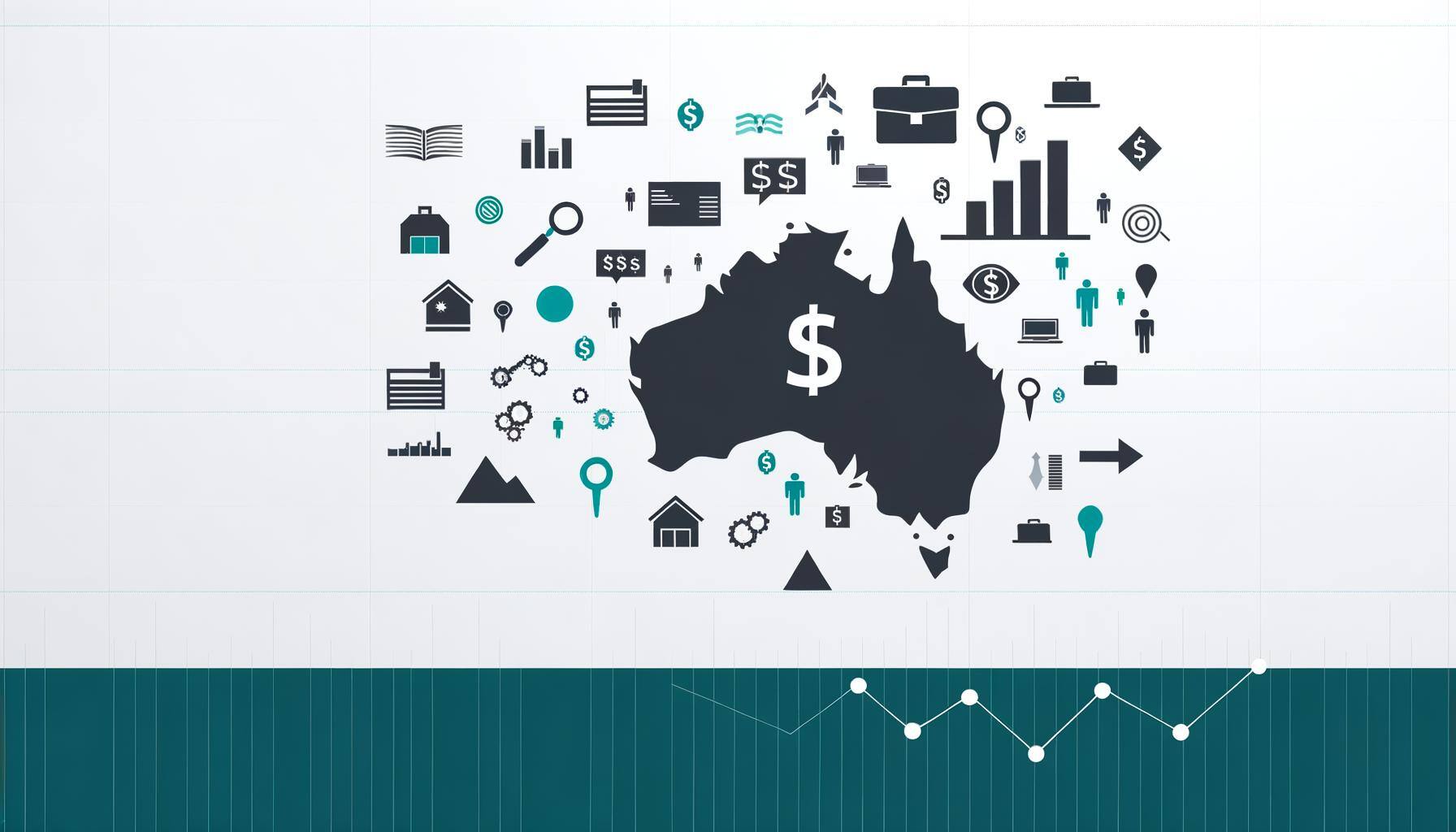Welcome to the top business news on 7 June 2024. Today's highlights cover the overheating Australian economy amidst inflation concerns, a concerning plunge in building approvals, shifts in gas policy in Victoria, and various other significant developments in the business realm.
Economy Heats Up as Inflation Remains a Major Concern
The Australian economy continues to overheat, despite being labelled as being in a "per capita recession". Experts stress the need for further moderation to bring inflation back to the Reserve Bank of Australia’s (RBA) target range of 2-3%.
Recent data shows the economy growing by a modest 0.1%, primarily driven by government spending and essential household expenses like electricity and rent. This fell short of market expectations and dropped annual growth to 1.1% in March, the lowest rate since the early 1990s recession, excluding the pandemic period.
Shadow treasurer Angus Taylor highlighted a “household recession” due to five quarters of declining GDP per capita. Simultaneously, Treasurer Jim Chalmers cited cost-of-living pressures for the sluggish activity. However, economists argue household spending is stronger than previously believed, following revised consumer spending data from the Bureau of Statistics.
EY chief economist Cherelle Murphy warned that despite apparent weaknesses, the RBA needs to stay vigilant. National Australia Bank economist Taylor Nugent noted that consumer weakness has been exaggerated. Betashares chief economist David Bassanese indicated recent GDP growth weakness could be temporary, expecting a rebound in exports and construction.
Despite weak GDP data, consumer spending on services remains robust, causing concerns for the RBA, especially with upcoming tax cuts on July 1 potentially increasing disposable income. Treasury forecasts a 3.5% rebound in real household disposable income next financial year, but only a 2% rise in spending, anticipating households will save rather than spend the extra income.
Australia’s post-pandemic spending surge is notable, with GDP per capita still 3% higher than pre-pandemic levels, surpassing many advanced economies. Revised data shows household consumption grew 2.1% last year, a healthier indicator of domestic demand. This suggests Australians are more resilient spenders than previously thought.
However, HSBC chief economist Paul Bloxham cautioned that weak demand must persist to stabilise inflation due to lingering supply constraints. Westpac senior economist Pat Bustamante remains optimistic, dismissing the likelihood of an impending recession but acknowledging households' dwindling savings buffers.
RBA Governor Michele Bullock emphasized the need to slow demand to match the economy’s supply capabilities, noting that output remains above levels compatible with low inflation.
Coolabah Capital’s recent research found Australia’s output gap is notably large, second only to the US among advanced economies. Domestic demand is 2% above pre-pandemic trends, indicating ongoing economic imbalances.
Overall, while the Australian economy faces slowing growth and high inflation, resilient consumer spending provides a mixed outlook.
Plunge in Building Approvals Alarms Housing Experts
Struggling Construction Sector Threatens Australia's Housing Targets
New data from the Australian Bureau of Statistics reveals a worrying trend: building approvals in April dropped by 0.3%, hitting a decade low. Experts warn this could spell trouble for the federal government’s ambitions to address the housing crisis.
State Approval Numbers Waver
Three out of seven states saw declines in approvals, with the Northern Territory remaining flat. Approvals in Western Australia, South Australia, Tasmania, and New South Wales showed a marginal increase, highlighting the uneven nature of the sector's performance.
Industry Pressures
Dr Michael Fotheringham from the Australian Housing and Urban Research Institute explained the broader trend. "We're facing declining consumer confidence in building new homes due to high interest rates and cost-of-living pressures," he said. Increased construction costs exacerbate the problem, despite the stable value of approvals. "We're investing the same money but getting fewer homes."
Ambitious Targets at Risk
The federal government’s target to build 1.2 million homes by 2029 faces significant hurdles. The recent allocation of $9.3 billion to states aims to kickstart this process from July 1, yet experts remain sceptical.
Industry Concerns
Matthew Kandelaars from the Property Council highlighted the multifaceted challenges: high construction costs, labour shortages, outdated planning systems, and tax laws discouraging global investment. "Conditions are challenging, making it incredibly difficult for the industry," Kandelaars said.
Moving from Approval to Action
Dr Fotheringham stressed the need to move beyond approvals to actual construction and occupancy. “Even if there's an approval, it doesn’t mean construction has commenced,” he noted. Achieving the national target will require consistent effort and collaboration across all levels of government and industry.
With approval rates declining and numerous industry hurdles, achieving Australia’s housing goals remains a daunting task. The government needs swift action and strategic partnerships to meet its ambitious targets.
Australian Economic Outlook: Interest Rates and Inflation
Economic growth in Australia is slowing, prompting calls for the Reserve Bank of Australia (RBA) to consider interest rate cuts to stave off a recession. Despite interest rate reductions in Canada and potentially Europe, Australia's economic path is distinct.
Canada has been more aggressive with interest rate hikes but has now begun cutting rates. In contrast, the RBA is taking a measured approach to avoid damaging the labour market while controlling inflation. Currently, the RBA's cash rate sits at 4.35%.
Headline inflation in Australia is at 3.6%, higher than Canada's 2.7%. Underlying inflation is also greater at 4% compared to Canada’s 2.9%. Australia's unemployment rate stands at a low 4.1%, against Canada’s 6.1%.
Avoiding Aggressive Measures
GSFM investment strategist Stephen Miller notes the differences between the two countries. Canada once made a 100 basis point hike, while the RBA is likely to hold rates until late this year or early next. The June quarter CPI may influence future decisions.
New deputy governor Andrew Hauser emphasizes the RBA's strategy to test how low unemployment can sustainably be, a plan agreed with Treasurer Jim Chalmers to justify lower interest rates for inflation control. However, if inflation remains high, the RBA might need to tighten rates more drastically later on.
Bullock’s View
RBA Governor Michele Bullock is currently comfortable with the 4.35% cash rate, stating that rate cuts would only occur if inflation falls sustainably into the 2-3% target range. Bullock noted that the economy is "very weak," marked by soft consumer spending.
Despite low GDP growth of 1.1% over 12 months, the economic output remains strong at $2.4 trillion, suggesting excess demand. The RBA aims for tepid growth, like the 0.1% in Q1, to balance demand with supply capacity.
A Delicate Balance
While Canada's aggressive approach has shown results, Australia opts for a more cautious path. If Bullock and the RBA can engineer a soft landing, it would be a significant achievement for the central bank.
Stay tuned for updates as we track the RBA’s next moves in this delicate balancing act.
Victoria's Gas Policy Shift: Industry's Relief and Concerns
The Victorian Labor government's recent gas policy reversal has received mixed reactions. Business groups have welcomed the approval of new gas exploration, questioning if it’s too little, too late for the state’s growing energy needs.
Energy Minister Lily D’Ambrosio’s green light for Beach Energy's offshore project near Port Campbell marks the first such approval since 2014. This decision, though appreciated, leaves businesses wary of prolonged delays in future projects.
Australian Industry Group CEO Innes Willox criticised the government for “demonising gas for the past decade,” emphasising that gas is vital for industry, not just households. Willox hopes Victoria won’t wait another decade to approve further projects, highlighting the risk of blackouts and industrial decline.
State Shadow Energy Minister David Davis echoed similar sentiments, blaming the government for not issuing a single gas exploration permit during its 10 years in office. He warned that Victoria faces energy shortfalls due to delayed actions.
Federal Resources Minister Madeleine King described the approval as a significant step toward Victoria’s energy security. Similarly, Steve Davies, CEO of the Australian Pipelines and Gas Association, stressed the need for a strategic shift to ensure reliable gas supplies for homes, businesses, and the economy.
Victoria aims for 95% renewable energy by 2035, with the rest from gas peaking plants. Since January, gas connections to newly built homes have been banned, aligning with the state’s aggressive climate goals. Onshore gas exploration was halted in 2012 and only resumed in 2020, while fracking and coal seam gas mining remain banned since 2017.
D’Ambrosio noted that gas plays a crucial role in the energy transition, approving Beach Energy’s project with the condition that gas is sold domestically first, contributing 10.6 petajoules annually against state demand of 188 petajoules.
“This decision supports Victorian homes and businesses to electrify, helping save on energy bills and preserving gas for essential uses,” D’Ambrosio said.
Victoria’s mixed policy signals leaves industries pausing in expectation, awaiting the long-term plans to unfold.
IDP Education Shares Plummet Amid International Student Restrictions
Investors in IDP Education have been hit hard as the company's shares tumbled by up to 12% on Thursday. The $4 billion firm, known for providing student placement and English language services in Australia, Canada, and the UK, has been under attack by short sellers and faced new government restrictions on international student numbers.
During the March quarter, visa applications fell 20-30% due to these caps, leading IDP to predict a 20-25% decline in its market over the next year. While IDP managed to cut costs, adjusted earnings before interest and tax (EBIT) for FY 2024 are expected to be flat, missing market expectations of 10% growth.
No clear guidance was provided for FY 2025, but IDP is preparing for further declines in student placements and English language testing. CEO, O’Shannessy, remains confident, stating, "We believe both business lines will outperform the broader market decline."
However, the market's hopes for 7% EBIT growth in 2025 have been dashed, and analysts are likely to revise their projections. Short sellers, who had increased their positions to 17.5% of IDP stock, are seeing significant gains as shares had already dropped 20% since January 1.
Election-Driven Decisions
O’Shannessy points to election cycles in the UK and upcoming polls in Canada and Australia as drivers of the current restrictions. Governments are facing pressure due to post-pandemic immigration, leading to a surge in house prices and cost-of-living issues.
Despite these challenges, long-term investors and O’Shannessy believe that education exports remain crucial for aging populations in these countries. She argues that IDP is well-positioned to gain market share during this disruption and stresses the importance of continued investment for future recovery.
“Once policy settings are neutralised, underlying intrinsic demand will flow,” she adds. However, it remains to be seen whether these restrictions are temporary or part of a long-term trend due to housing affordability crises in all three countries.
Kieran Kennedy of Mirrabooka describes IDP as a five-year bet, expecting the company to strengthen its market position eventually. Patience may be necessary as housing and immigration issues play out.
ACTU Congress Highlights Leadership and Unity Amidst Challenges
Prime Minister Anthony Albanese hailed ACTU leaders Sally McManus and Michele O’Neil as the “magnificent duo” during the congress dinner on Wednesday night. The pair, re-elected unopposed for the next three years, steered a carefully managed union congress towards prioritising shorter hours, climate policy, and tackling artificial intelligence.
Backstage, they're supported by influential left and right leaders who steer clear of internal conflicts.
Dynamic Left Leaders
Steve Murphy, national secretary of the Australian Manufacturing Workers Union (AMWU), drives Labour’s multi-employer bargaining laws. Despite reduced membership from the car manufacturing exit, Murphy's union recently submitted its first deal under these laws. “It’s amazing what we can achieve when we stop caring who gets the credit,” he said, emphasising unity in organising green industry jobs.
Gary Bullock, United Workers Union Queensland boss, effectively coordinates leftist efforts while maintaining a low profile. Although not visibly active on the floor, Bullock's influence is significant. Similarly, Zach Smith, CFMEU national secretary, works to push Labour leftward, although notable state secretaries from his union, like John Setka, were absent due to tensions with ACTU leadership.
Strategic Right Faction
Gerard Dwyer, national secretary of the Shop Distributive and Allied Employees Association (SDA), manages resolutions for the right. The SDA, despite its conservative roots, has become more activist. It proposed notable resolutions such as five days’ annual leave for all workers and ending youth wage discrimination for 18- to 20-year-olds. Dwyer aims to harmonise factional differences as ACTU’s senior vice president.
Avoiding Division
Since Labour's unexpected loss in 2019, unions have committed to collective discipline. Controversial topics like AUKUS and Gaza stayed off the congress floor. The ACTU’s nuclear-free policy clashes with the Albanese government’s nuclear submarine purchase. Fringe events discussed these issues behind the scenes, reflecting a strategy to avoid public division.
More than 50 resolutions, including pro-Israel amendments to Palestinian statehood policy, did not proceed to public debate, showcasing a deliberate push for unity and cohesion within the union movement.
By prioritising cooperation and purpose-driven dialogue, the ACTU Congress sought to navigate internal and external challenges effectively.
Bendigo Health Declares Code Yellow Amid COVID-19 and Flu Surge
Bendigo Health has declared a code yellow internal emergency due to a spike in patients with COVID-19 and influenza. Hospital staff say the facility is "unprepared" and urge the Victorian government to rebuild the health system.
Patient Care and Strain on Resources
Despite the emergency status, surgeries continue as planned, prioritising the most serious cases first. Nurses report the hospital is overwhelmed, with every bed occupied. Support staff trained in nursing have been pulled into intensive care and emergency departments.
Damian Hurrell, an intensive care nurse with 23 years of experience, shared his challenging experience. "Every bed was full. Colleagues were coming out of support roles to provide clinical care," Hurrell told ABC Central Victoria.
Staff Burnout and Resource Stretched Thin
Hospital workers describe the situation as chaotic. Ambulance trolleys crowd emergency department corridors, and many staff report extreme fatigue. Last year, a survey revealed that 50% of Bendigo Health staff plan to leave within two years.
Rise in Respiratory Illnesses
The internal emergency was triggered by an increase in COVID-19 and respiratory illness patients. Bendigo Health advises the public to seek alternatives to emergency care if possible and get vaccinated against COVID-19 and flu.
Government Response and Future Measures
Victorian Premier Jacinta Allan, representing Bendigo East, hasn't been briefed on the code yellow but urges residents to stay home when sick to reduce strain on hospitals.
Health officials state the system is fundamentally overburdened. Dr. Simon Judkins from the Australian Medical Association stresses the critical state of the health system, noting higher mortality rates and longer hospital stays.
Calls for System Overhaul
Nurses at Bendigo Health have rejected the latest pay offer, finding it insufficient, and demand systemic rebuilding to combat burnout and retain staff.
Geraldton Health Campus Upgrades Back on Track
Long-Awaited Development Underway
After years of delays and budget blowouts, the Geraldton Health Campus is finally seeing the much-anticipated upgrades come to life. Initially promised by the Labor government during the 2017 election, the project faced multiple setbacks, marking it as WA's most delayed endeavour.
What's New?
The upgrades include:
- An expanded emergency department
- New inpatient mental health facility
- State-of-the-art intensive care unit
Premier Roger Cook announced the commencement of construction today, attributing previous delays to COVID-19, global supply chain issues, and worker shortages. “Health facilities are complex builds, a challenge faced across Australia,” Cook stated. “But it's a relief to finally be here.”
Budget Issues Resolved
Originally set at $73 million, project costs soared to $166 million. Despite these hurdles, Cook assured the public that the upgrades are now firmly back on track. Completion is expected within 18 months to two years.


